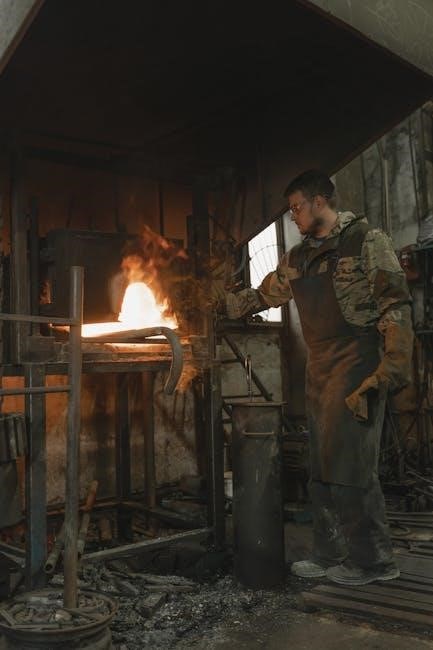The Goodman Furnace Service Manual is an essential resource for HVAC professionals and homeowners‚ providing detailed guidance on installation‚ troubleshooting‚ and maintenance procedures to ensure optimal furnace performance and safety.
Overview of the Goodman Furnace Service Manual
The Goodman Furnace Service Manual is a comprehensive guide designed to assist HVAC professionals and homeowners in understanding and maintaining their furnace systems. It covers essential aspects of furnace operation‚ troubleshooting‚ and repair‚ ensuring safe and efficient performance. The manual is structured to provide clear‚ step-by-step instructions for diagnosing common issues‚ such as ignition problems‚ draft motor malfunctions‚ and error code interpretations. It also includes detailed schematics and diagrams to help users identify components and perform repairs effectively. Regular maintenance tasks‚ such as filter replacement and system inspection‚ are emphasized to prevent breakdowns and optimize energy efficiency. Additionally‚ the manual addresses advanced diagnostic techniques‚ enabling users to resolve complex issues promptly. By following the guidelines outlined in the manual‚ users can extend the lifespan of their furnace and ensure reliable heating performance throughout the year.
Importance of the Service Manual for HVAC Professionals and Homeowners
The Goodman Furnace Service Manual is a vital tool for both HVAC professionals and homeowners‚ offering comprehensive guidance for troubleshooting‚ maintenance‚ and repair. For professionals‚ it ensures efficient diagnosis and resolution of complex issues‚ minimizing downtime and enhancing customer satisfaction. Homeowners benefit by gaining insights into routine maintenance tasks‚ such as filter cleaning and error code interpretation‚ empowering them to address minor issues independently. The manual’s detailed instructions and diagrams provide a clear understanding of furnace components and operations‚ fostering safety and optimal performance. By adhering to the manual’s recommendations‚ users can extend the lifespan of their furnace‚ reduce energy costs‚ and maintain reliable heating. Whether for professional servicing or DIY maintenance‚ the Goodman Furnace Service Manual is an indispensable resource for anyone seeking to maximize furnace efficiency and safety.

Troubleshooting Common Issues
Troubleshooting common issues with Goodman furnaces involves checking LED error codes‚ diagnosing ignition and draft motor problems‚ and resetting the furnace to address power-related malfunctions effectively.
Understanding LED Error Codes on the Furnace Control Board
The Goodman furnace uses LED error codes to indicate specific issues‚ helping technicians diagnose problems quickly. A steady red LED often signals a failed control board‚ requiring thermostat wire disconnection and a system reset. Flashing codes‚ such as alternating red and green‚ may point to ignition or draft motor faults. Consulting the service manual is crucial‚ as it provides detailed explanations of each code and corresponding solutions. For example‚ if the draft motor activates but the ignitor fails‚ the manual guides you through checking gas flow and ignition components. Regularly referencing the manual ensures accurate troubleshooting‚ preventing further damage and ensuring safe‚ efficient furnace operation. Always follow the manual’s instructions to address error codes promptly and effectively.
Diagnosing Ignition Problems and Draft Motor Issues
Ignition problems and draft motor issues can prevent the furnace from operating efficiently. If the ignitor fails to light‚ check for proper voltage supply and ensure no blockages in the ignition system. A faulty draft motor may cause the furnace to shut down‚ as it disrupts proper airflow for combustion. Inspect the motor for signs of wear or obstructions and ensure it operates smoothly. Refer to the service manual for specific error codes related to these components‚ as they can guide precise troubleshooting steps. Regular maintenance‚ such as cleaning the draft motor and ensuring all connections are secure‚ can prevent these issues. Always power off the furnace before performing any inspections or repairs to ensure safety. Addressing these problems promptly helps restore heating efficiency and prevents potential safety hazards.
How to Reset the Furnace and Troubleshoot Power-Related Problems
Resetting your Goodman furnace and addressing power-related issues can often resolve operational problems. Start by checking the circuit breaker or fuse box to ensure the furnace has power. If a breaker is tripped or a fuse is blown‚ reset or replace it. Next‚ locate the furnace’s reset button‚ typically found near the blower motor or on the control board. Press and hold the reset button for 5-10 seconds to restart the furnace. If the issue persists‚ inspect the thermostat wiring and connections for any damage or loose links. Ensure the thermostat is set to “heat” mode and the temperature is above the current room temperature. If the furnace still doesn’t operate‚ refer to the service manual for specific error codes and troubleshooting steps. Regular maintenance‚ such as cleaning the furnace filter‚ can also prevent power-related issues and improve efficiency. Always consult a professional if problems recur or worsen over time.

Key Components of the Goodman Furnace
The Goodman furnace features a control board‚ draft motor‚ and ignitor‚ each playing a critical role in ensuring safe and efficient heating operation and performance.
Overview of the Furnace Control Board and Its Functions
The furnace control board is the central nervous system of the Goodman furnace‚ regulating all operational functions to ensure safe and efficient heating. It monitors temperature levels‚ airflow‚ and system performance while managing components like the ignitor‚ draft motor‚ and blower. The control board interprets thermostat signals‚ activating the furnace when heat is requested. It also incorporates safety features‚ such as shutting down the system if it detects issues like overheating or improper airflow. LED error codes on the board provide diagnostic insights‚ helping technicians identify and resolve problems quickly. Regular inspection and maintenance of the control board are crucial to prevent malfunctions and ensure reliable furnace operation. By understanding its functions‚ homeowners and HVAC professionals can better troubleshoot and maintain the furnace‚ optimizing its performance and longevity. This component is vital for maintaining indoor comfort and safety.
The Role of the Draft Motor and Ignitor in Furnace Operation
The draft motor and ignitor are critical components in Goodman furnace operation. The draft motor ensures proper airflow for combustion‚ venting gases safely outside. The ignitor‚ often a hot surface igniter‚ lights the gas burner when the thermostat calls for heat. Both components work together to maintain efficient and safe furnace operation. If the draft motor fails‚ the furnace may not vent properly‚ leading to shutdown. Similarly‚ an faulty ignitor can prevent the burner from lighting‚ resulting in no heat. Regular inspection and maintenance of these parts are essential to prevent issues and ensure reliable performance. Understanding their roles helps in diagnosing problems quickly‚ as outlined in the service manual.

Maintenance and Repair Tips
Regular maintenance tasks‚ such as cleaning or replacing the furnace filter and inspecting the draft motor and ignitor‚ ensure optimal performance and prevent unexpected repairs.
Regular Maintenance Tasks to Ensure Optimal Furnace Performance
Regular maintenance is crucial for maintaining the efficiency and longevity of your Goodman furnace. Start by replacing or cleaning the furnace filter every 1-3 months‚ as a dirty filter can reduce airflow and increase energy bills. Next‚ inspect the draft motor and ignitor for proper function‚ ensuring they are free from dust or debris. Check the venting system for blockages or leaks‚ as improper ventilation can lead to safety hazards and reduced performance. Additionally‚ ensure the furnace area is clear of clutter to maintain proper airflow. Finally‚ schedule an annual professional inspection to address complex issues and validate warranty coverage. These tasks‚ outlined in the service manual‚ help prevent breakdowns and ensure your furnace operates safely and efficiently year-round.
How to Replace or Clean the Furnace Filter for Improved Efficiency
Regularly replacing or cleaning the furnace filter is crucial for maintaining optimal performance and efficiency. Locate the filter according to the Goodman Furnace Service Manual‚ typically found in the return air duct or near the furnace. Turn off the power supply before removing the filter. If it’s disposable‚ replace it with a new one of the same size and type. For reusable filters‚ vacuum or wash them gently and allow them to dry completely before reinstalling. A clean filter improves airflow‚ reduces energy consumption‚ and prevents potential damage to the furnace. Replace or clean the filter every 1-3 months‚ depending on usage. Refer to the manual for specific recommendations tailored to your Goodman furnace model.

Advanced Diagnostic Techniques
Advanced diagnostic techniques involve interpreting error codes and performing detailed system checks to pinpoint faults‚ ensuring efficient resolution of complex furnace issues using the service manual’s guidance.
Using the Service Manual to Identify and Resolve Complex Issues
The Goodman Furnace Service Manual is a crucial tool for diagnosing and resolving complex furnace issues. It provides detailed instructions for interpreting LED error codes‚ troubleshooting ignition and draft motor problems‚ and addressing unexpected shutdowns. By referencing the manual‚ HVAC professionals and homeowners can identify root causes of malfunctions‚ such as faulty sensors or electrical connections. Advanced diagnostic techniques outlined in the manual enable precise identification of failed components‚ ensuring repairs are efficient and effective. For instance‚ if the draft motor fails to activate‚ the manual guides users through checking voltage supply and verifying wiring connections. Similarly‚ error codes can be cross-referenced to pinpoint issues like gas valve malfunctions or pressure switch problems. Regularly consulting the manual helps users maintain furnace performance and prevent recurring issues‚ ensuring reliability and safety. This resource is indispensable for anyone aiming to resolve complex furnace problems effectively.
Interpreting Error Codes and Taking Corrective Actions
Understanding error codes is crucial for diagnosing and resolving furnace issues efficiently. Goodman furnaces use LED indicators to signal specific problems‚ such as a steady red light‚ which often points to a failed control board. Other codes may indicate issues with the ignitor‚ draft motor‚ or gas valve. Referencing the service manual is essential to decode these signals accurately. For example‚ if the ignitor fails to glow‚ check for proper gas flow‚ clean the burner‚ and ensure the ignitor is functioning. If the draft motor isn’t operating‚ inspect for blockages in the venting system. Resetting the furnace or replacing faulty components can often resolve these issues. Always consult the manual for detailed corrective actions and safety precautions to avoid further damage or hazards. Regularly reviewing error codes ensures timely repairs and maintains optimal furnace performance.
Regular maintenance‚ troubleshooting‚ and proper installation ensure optimal performance and safety of your Goodman furnace‚ as outlined in the service manual for HVAC professionals and homeowners.
Final Tips for Effective Furnace Service and Maintenance
To ensure your Goodman furnace operates efficiently and safely‚ always refer to the service manual for model-specific guidance. Regularly inspect and clean the venting system to prevent blockages‚ and ensure proper airflow around the furnace. Consider upgrading to a programmable or smart thermostat for better temperature control and energy savings. Schedule annual professional tune-ups to identify potential issues before they escalate. Keep the furnace area clear of clutter to avoid fire hazards and maintain proper functioning. If you notice unusual noises‚ odors‚ or performance issues‚ address them promptly to prevent costly repairs. Finally‚ always turn off the power and gas supply before performing any DIY maintenance tasks. By following these tips‚ you can extend the lifespan of your furnace and enjoy reliable heating performance year-round.



